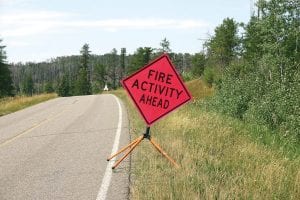there secret
A dozen members of the public attended the April 29 East Zone prescribed burn meeting hosted by the US Forest Service at the Poplar Lake Fire Hall on the Gunflint Trail. Mike Crook, Bre Schueller, Dennis Neitzke, Patty Johnson, Kurt Schierenbeck, and Steve Schug represented the Forest Service.
Dennis Neitzke, District Ranger, discussed significant natural events on the Gunflint Trail over the past 15 years, and said the Superior National Forest just celebrated its 100-year anniversary.
What did the Superior look like in 1909? “It was mostly burned over or logged over,” according to an account from the first Superior National Forest supervisor.
Patty Johnson, fuels planner, explained that historically, fires (lightning and human-caused) have occurred frequently in the vicinity of the midtrail area. This is why she is concerned about the midtrail area potential of fires growing from south to north in that area or, as was the case with Ham Lake, fires traveling in any direction.
Fire history says that we will have fire in our area at some point, Johnson said. The prescribed burn program will be continued along the trail because it’s not just blowdown but old vegetation on the forest that hasn’t burned for over 100 years.
Homeowners should continue to work on private property for fuel reduction, said Johnson, and there are still grant opportunities to do Firewise work.
Mike Crook, fuels technician, then talked about the BWCAW burns planned for 2009.
Included are:
• Caribou Rock, 264 acres, which would be best to
do in the spring, although it could be done at other times. No set date; weather dependent. Temporary closures are possible; there could be escorts on the portages.
What can residents on Hungry Jack Lake expect while the burning takes place? Low intensity fire, except for in blowdown; multiple days of operational personnel; aircraft in the area; individual tree torching – but mostly ground fire. Forest Service will call smoke-sensitive persons prior to ignition.
What can people expect to see after it is burned? What is it going to look like afterwards? Crook said the area around the pine has been cleared to reduce the mortality; visuals include black ground for several weeks, torched out balsam; lowland areas probably will look the same because they are wet and likely will not burn; expect 10 to 20 percent mortality in the pine – especially those affected by blister rust; pine evolved with fire and have thick bark so most healthy pine will have a better chance at survival. The area will see increased blueberries, wildflowers, and diverse age class of pine.
Dawkins, 1,930 acres encompassing conifer blowdown (patch burn) with balsam regeneration. Expect high intensity fire with this burn inside the patches of blowdown. Campsites and a short section of the Banadad Trail may experience closures.
Meeds, 1,626 acres, hardwood mix with balsam regeneration targeting pockets of blowdown. Expect high intensity fire with this burn inside the patches of blowdown. Section of the Banadad Trail and some campsites will see closures.
Duncan, 4,838 acres of blowdown/under burn pine. Hand lighting will be practiced in some areas where foot travel is accessible and safe. Entry points will be closed only when necessary to ensure visitor safety.
Border Units, 3,648 acres targeting blowdown and some under-burning of pine near patches of blowdown. There will be no active ignition along shorelines of Clearwater Lake but fire may creep down to
shore in some places.
Residents will be notified prior to implementation of the burn so if they want to run their sprinklers, they can. The Gunflint Trail Volunteer Fire Department will assist homeowners.



Loading Comments